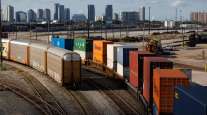Expanded Canal Offers Only Modest Savings to Shippers, U.S. Maritime Consultant Says
This story appears in the Feb. 20 print edition of Transport Topics. Click here to subscribe today.
The expansion of the Panama Canal will have the greatest effect on shipments to a handful of states stretching from Ohio to Georgia but will offer only modest cost savings to shippers, a consultant to the U.S. Maritime Administration said.
Scudder Smith, who is also a principal consultant at engineering firm Parsons Brinckerhoff, gauged the effects of the $5 billion canal expansion on U.S. shipping patterns during a Feb. 10 webcast sponsored by an investment bank.
He said shipments bound for the area between Ohio and Georgia — including Kentucky, Tennessee and adjacent states — are most likely to switch from the West Coast to the East Coast because of the freight cost savings, which he estimated for shippers at about $200 per load.
The project that is set to be completed in 2014, the canal’s centennial, includes building a third set of locks as well as widening and deepening channels to accommodate ships carrying 13,000 of the industry standard 20-foot container units. Today, the largest ship that can fit through the canal carries 5,000 of those units.
“The frenzy about coastal shifts is likely overblown,” Smith said, dismissing views that the canal expansion would have a “volcanic” effect on shipping patterns. “There will be shifts [between coasts], but it won’t be as explosive as some imagined.”
Asked how much of a shift to expect from West Coast ports to East Coast ports, Smith said estimates “would be highly speculative.”
“We do not have some key information that is needed to make such an estimate,” he told Transport Topics.
Smith also tried to limit expectations about cost savings.
“The basic and the really important point is that the impact of cost reductions are not what you imagined them to be,” he said on the Stifel, Nicolaus & Co. webcast.
On average, shipping costs from Asia to the East Coast could drop about $400 because of the savings generated by larger ships.
However, he said half of those savings wouldn’t reach shippers because will retain part of the money as profit and some will go to pay higher Canal tolls.
Another reason for limited shifts between coasts is the fact that shippers of high value cargo such as electronics are likely to continue to use West Coast ports because of the transit time differential, he said.
Freight unloaded on the West Coast can arrive up to two weeks faster at inland U.S. destinations by train and/or truck than freight than all-water trips through the canal and an Atlantic Ocean port, he added.
The Panama Canal project will cause some changes in shipping patterns, he emphasized, as ports will have to compete harder to attract the larger ships.
“The global shipping industry is very significantly affected by and will affect the Panama Canal,” Smith said. “The same goes for port development.”
The advent of larger ships also is affected by individual port characteristics, Smith said.
Potential beneficiaries on the East Coast could be New York/New Jersey, Norfolk, Va., and Baltimore, which can be accessed by larger ships needing channels that are 50 feet deep.
The opportunities in the southeast are more of a question, Smith said.
Ports such as Savannah, Ga., and Miami are trying to increase their capacity to handle goods, as they also are trying to deepen harbors and enhance port capacity, Smith said.
Smith cited another reason for limited shifts in cargo between coasts — the potential for West Coast ports to reduce costs by handling ships over 13,000 20-foot units that won’t fit through even the enlarged Panama Canal.
He also emphasized the importance of the project to Panama itself.
“Without the canal expansion, Panama’s role in the global economy would have been diminished,” Smith said.
Smith also said that the canal by itself won’t have a measur-able improvement in the global economy.
He described the broad economic impact of expansion as a “zero-sum game” because the new canal-related economics will simply change the U.S. port of entry and won’t create more underlying demand.


